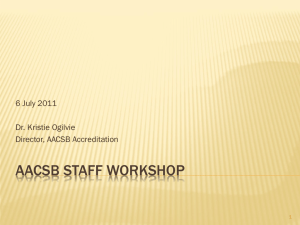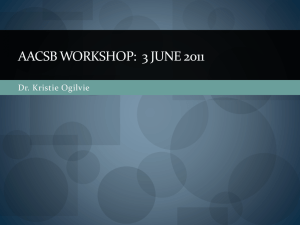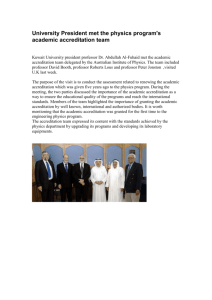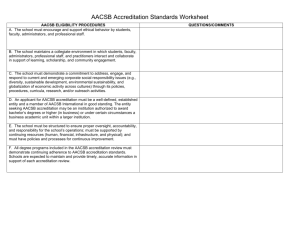AACSB Informational Workshop - College of Business and Public
advertisement
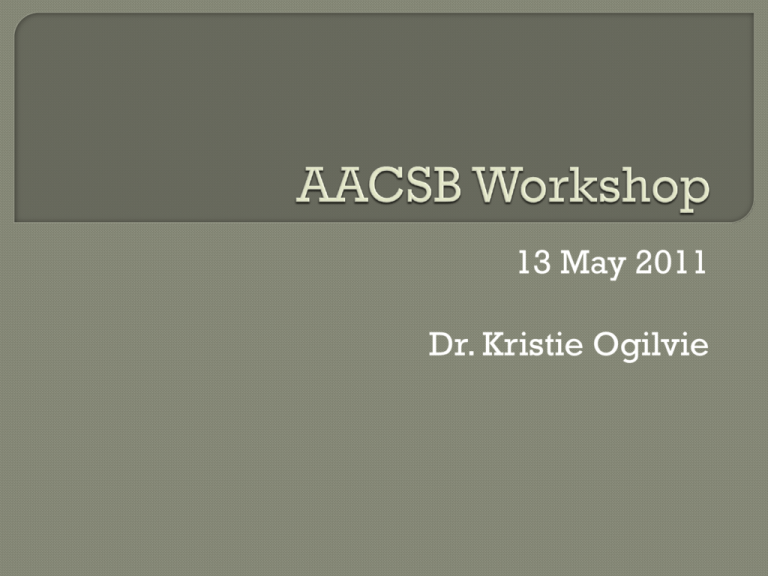
13 May 2011 Dr. Kristie Ogilvie Introduction of the AACSB Organization Accreditation • Strategy / Mission • Faculty Qualifications • Assurance of Learning Learning Goals Curriculum Map Recent Trends and Future Actions Standards – No Notation ICAM 2011 – Annual Conference BPAV 2011 - Best Practices from Accreditation Visits MOA 2011 – Maintenance of Accreditation Conference AAS 2010 - Applied Assessment Seminar USW 2009 - Updated Standards Webinar Dean AACSB Accreditation Strat. Plan. Com (Faculty) Dean Director of Accreditation (Ogilvie) Analyst (Flynn) ASC (Wells) Strategy / Mission Faculty Qualifications Standard 1-15 AQ/PQ Graduate Courses Digital Measures Publication Quality Standard 2, 9, 10* Assurance of Learning Undergraduate Graduate MSA Offsite & Online Standards 16-21* *Focus of Interim Report , 5th Year Report and Visit Documentation Liaison: 1. AACSB Contact 2. University Relations Milestones: 1. Interim Report 2. 5th Year Report 3. On Site Visitation Advanced quality management education worldwide through…… Accreditation . . Thought Leadership Value Added Services AACSB was established in 1916. Headquarters in Tampa, Florida. Accreditation is • awarded base on 21standards. • made at the institutional level. • is awarded in business, accounting, or both. • awarded to less than 10% of Business Schools Worldwide. Accredited Institutions • In 2011, 694 total, 620 in North America In Process 184 – Mostly International. Standards • Description of requirements • Less information on the “how to” Interpretive material provided as a supplement Conferences, seminars, webinars, whitepapers cover acceptable and best practices. Mission / Strategy - Standard 1-5 Faculty Qualifications - Standard 6-15 Assurance of Learning - Standard 16-21 Initial accreditation must cover all standards Maintenance of accreditation covers the areas of weakness from last 5 year visit Upon initial accreditation an interim report is due 2.5 years (July 2011) Every five years, a visit occurs in which a full report is due. Mission and Strategy A school articulates its mission and action items as a guide to its view of the future, planned evolution, infrastructure, and use of resources. The strategic management standards verify that a school focuses its resources and efforts toward a defined mission as embodied in a mission statement. • What is the overall mission to your organization? • How are resources deployed to support your mission? • How are your programs deployed to support your mission? Profit / financial incentive is not enough of a reason for deployment. (BPAV 2011) Strategic Plan • Managed through strategic planning committee • Primarily teaching based mission • Diverse student base Areas for Concentration • Deployment of programs: MSA, Online MBA, International Partnerships • Institutional accreditation Excluding programs from accreditation If 25% or more of the program is taught by business faculty, it can not typically be excluded Economics and International Faculty Qualifications A direct link exists between: • a school’s mission • the characteristics of students served by the educational programs • the composition and qualifications of the faculty members providing the programs • the overall quality of the school. A clear policy must be in place that delineates AQ / PQ criteria. Documentation must be maintained to substantiate the status designation in a portfolio. PRJs are universally required, though other ICs are expanding (MOC, 2011) At least 90-percent of faculty resources are either academically or professionally qualified. At least 50-percent of faculty resources are academically qualified. Trends (ICAM, 2011) . AQ PQ • 2002-2003 73% 22% • 2009-2010 63% 30% To be AQ, one must hold a doctorate degree • Non-AACSB schools or programs may be questioned, in which a portfolio of ICs must be provided (ICAM, 2011) • Recent graduates receive a 5 year window to reach AQ standards • PhD students have 3 years to reach their graduation once ABD status is met IC policy set by school and compared to peers. (ICAM, 2011) Normally, the professional experience should be relevant to the faculty member's teaching assignment, significant in duration and level of responsibility, and current at the time of hiring. • Once hired, the PQ status is granted for a five year period. • If the duration of employment is over five years, a portfolio of continued professional activity must be maintained. Regardless of the type of contractual relationships between faculty members and the school, the faculty is sufficient in numbers and presence to perform or oversee the following functions: • Curriculum Development • Course Development • Course delivery: The obligations specified in the Assurance of Learning standards are met. • Other activities that support the instructional goals of the school's mission, such as faculty development activities, community service, institutional service, service in academic organizations, economic development. Participating faculty members will deliver at least 75-percent of the school's teaching (whether measured by credit hours, contact hours, or other metric appropriate to the school). Normally, Participating faculty members will deliver at least 60-percent of the teaching in each discipline, each academic program, and location. Ratios must be tracked and reported in each discipline, each academic program, and location. A single dip in ratios does not jeopardize accreditation, though corrective action must be reported and taken. Policy Defined: AQ/PQ, Graduate Teaching and P/S • Update of Digital Measures Necessary Area of Concentration • Recent trends issues (ICAM 2011) Vitas matching database and tables Non-AACSB Doctorates PhD Students Incentive programs underway • AQ and Research • Research Quality for: Assurance of Learning Student learning is the central activity of higher education. Definition of learning expectations and assurance that graduates achieve learning expectations are key features of any academic program. The learning expectations derive from a balance of internal and external contributions to the definition of educational goals. Learning goals should be set and revised at a level that encourages continuous improvement in educational programs. Assurance of Learning Framework • Create learning goals that reflect the outcomes that an institution want students to obtain upon graduation. • Assess student learning, based on those learning goals. • Analyze and report results of the data from the assessment process to the stakeholders. • Drive change for continuous improvement from the assessment program. – “Closing the loop”. AACSB states accredited schools must illustrate a mature system for collecting and assessing data for maintaining accreditation, outlined from the AACSB standards. “For schools with visit years in 2007-08 and beyond, the impact of assessment outcomes on continuing development of degree programs should be evident.” (AACSB 2011, p. 69) Methodology is sound (reliable and valid) • Established and well thought out learning goals • No group data • Mature rubrics for assessment and rater reliability Not a major concern, except if shows to be an issue (such as no improvement necessary for a majority of learning goals) • Assessment Course selection Does not exclude any set of students that makeup the program Consistency between courses for multi course sample (i.e. PA 315) Portfolios / Comps No selection bias (population / e-portfolios) Faculty driven Data drives change in curriculum Issues discussed in “recent trends” • Mounds of data, does not drive change and improvements of curriculum *** Accumulation of discussions from seminars/conferences Universal Skills that all students should possess through development in their program upon graduation • Four to six recommended. • Goals can vary per program • “Less is more... assess four learning goals well, rather than six with less quality” (Trapnell, MOC 2011) Examples from AACSB Material • Leadership, Globalism, Teamwork, Information Technology, Oral Communication, Written Communication, Ethical Reasoning, Problem Solving, etc. One Direct Measure of each learning goal required. • Direct = Student Assessment Indirect learning goals, as necessary. • Syllabi analysis, employer surveys, faculty feedback, etc. Two cycles of data collection and analysis required each five year cycle. There are three most accepted data collection methods (over 97% of institutions use one of these methods): • (1) Selection Entrance exam, such as SAT or GMAT • (2) Course embedded measures • (3) Stand alone testing Graduation exam Programs have two options for selection of their data target • (1) assessment of each concentration • (2) assessment of the core courses of a program Virtually every school uses the core course program technique (ICAM 2011) FACULTY DRIVEN Director of AACSB Accreditation: • • • • Chair of faculty AoL committee. Facilitate and focal point for all tasks related to assurance of learning. Includes graduate (MBA/MSA) and undergraduate levels. Works directly with the administrative leadership for advisory for the AoL programs. Assurance of Learning Committee: • The Director and six members of the faculty will make-up the strategic assurance of learning committee. • Tasks include assessment of the undergraduate and graduate (MBA/MSA) programs, assessment of all core syllabi in programs annually, and the assessment of the non-traditional offerings (online and off site courses/programs). • Various other tasks will be assigned as needed, such as curriculum mapping, rubric refinement, department meetings status, etc. Leadership Stakeholders: Dean, Associate Dean, Chairs, and MBA Director will provide input in relation to AoL from an administrative perspective. Other Stakeholder Groups: Various other stakeholders, such as the department faculty, curriculum committees, graduate committee, strategic planning committee, University assessment leadership and committee, etc. Communication, Oral Communication, Written Problem Solving Skills • Innovative for UG/MBA Ethical Reasoning Skills Informational Technology • Not included for MSA General and Specific Management Knowledge and Skills Oral Communication • Assessment Oral presentation in class, though participation is not enough Group presentation is acceptable, though assessment is captured at the individual level • Syllabi Analysis*** Oral presentation discussed in grade section or schedule of syllabi Written Communication • • • • Problem Solving • • Needs to be an individual assignment** At least 2 pages Can be in- or out-of-class assignment Mature framework would have consistent content, textbook, assignments between sections* Individual Assignment** Essay style submission *Not consistently applied with UG framework, except PA315. **Not consistently applied with MBA framework ***Only at UG level Ethical Reasoning • Assessment Essay style submission for assessment** • Syllabus analysis* Coverage in course with learning outcomes, content covered in course, and/or assignment. Most approved texts have a chapter or portion of text related to ethics in various disciplines. Information Technology • Project based assignment Management and Specific Skills • BAT Test First valid and reliable exam issued in Spring 2011, have been piloting since 2009. • Comp / Portfolio Aggregated data compiled from each chair of the comp committee*** *Analysis only at UG level **Not consistently applied to with MBA. ***Not acceptable practice from AACSB perspective. Course Embedded Measures • • • • Core Course Methodology Double Blind External Review Process (Single moving forward) Framework Piloted, looking to standardize, like PA315. Rubrics Refined from a 3 category system to a 5 category system, has resulted in more meaningful data. Individual Courses • • Oral Written MGMT490 PA315/MGMT302 Varied faculty buy in • • INFO Problem Solving INFO 309 MGMT302 Varied faculty buy in and assessments. • Ethics PA315 Varied assessment during pilot, matured system now in place. • MGMT Specific MGMT490 Spring 2011 first valid and reliable test. Online Courses and PDC • • Issues obtaining data in a timely manner . Not enough core courses, expanded to concentration courses for online classes. Oral Presentation – Course Embedded, Instructor assessment • Invasion of instructor priorities during oral presentation of students. Portfolio Analysis - Student select three assignments for five learning goal illustration. • • • • Student selection of assignments Group and individual data collection Lack of comparable data between portfolios Some learning goals not present for assessment Comp Exam – Aggregate data collection by each concentration. • Comparable data between concentrations • Aggregating rubrics for comp exams Both core and concentration courses are selected in assessment. Four of five learning goals showing no improvement necessary. • 3 category system. Data Collected every year (rather than the two cycles every five years). Proposal for improved framework in work for Spring 2011. Goal to accelerate maturity to meet standards in 2013. Oral Communication Written Communication* Problem Solving * Ethical Reasoning* Information Technology** Specific Content Skills UG MGMT490 MBA MGMT685 MSA ACCTG 615 MGMT601 Essay Essay PA315, MGMT302 MGMT302 PA315 MGMT601 MGMT601 Culm. Exp. Or ACCTG620 Culm. Exp. ACCTG 620 Project INFO309 INFO609 NA Exam MGMT 490 MGMT685 or Culm. Exp. comp Method Course Eval. Essay * Two Learning Goals can be combined via one measure ** IDS Planning Necessary for Inclusion AY 09-10 10-11 11-12 12-13 Cycles completed Undergraduate Ethics, Info Tech, Gen MGMT Written, Oral, Problem Solving, Gen MGMT Pilot UG: All LGs Close Loop 2 MBA Portfolio/Comp MSA Conceptualization Portfolio /Comp Framework Defined Pilot: All LGs All LGs 2 Pilot: All LGs All LGs 2 (Portfolio) and 2 (Course Embedded) Skill Previous Cycle 3 category Cycle 2 5 category Cycle 3 Oral 36% 7% Spring 2011 Written 30% 41% Spring 2011 Problem Solving NA 40% Spring 2011 Info Tech 7% 11% Spring 2012 Ethics 17% 15% Spring 2012 MGMT Skills 48% (47% CSU) 49% (49% CSU) 48.9% (52% CSU), Skill Cycle 1 Cycle 2 Cycle 3 Oral n/a 6% 12% Written 2% 5% 27% Problem Solving 0% 3% 7% Info Tech 2% 13% 0% Ethics 13% 31% 6% MGMT Specific Skills 0% 18% 7% Undergraduate Framework: • MGMT 306 Curriculum Change for Prerequisite of CBPA program courses: 34 courses will implement the prerequisite from all departments in the CBPA. • Human Resources Concentration Approval by SHRM/AACSB: 13 specific learning outcomes that must be aligned in a concentration prior to approval by Society for Human Resources (SHRM). Need more results with each learning goal in this area. Majority of learning goals resulted in less than 10% of students at unacceptable levels. Faculty Action • Include Learning Goals in Syllabi and course content • 2 of 3 assignments in portfolio should be individual There are not enough individual assignments to cover the required three assignments • 3 assignments required, but five learning goals Need one assignment to cover multiple learning goals Ethical reasoning assignments limited. • Encourage students to go to writing center Comp exam feedback • See Communiqué - feedback by concentration Core Course Committee Revitalization at the Undergraduate Level or other faculty driven process • Consider at Graduate Level Rubric Refinement, all Programs. Syllabi analysis and improvements at undergraduate levels • Consider at Graduate Level Dream Project The team found that the College has not developed an assessment program that leads to improvement in the undergraduate and MBA programs. Particular concern: • Closing the Loop: “the impact of assessment outcomes • • • • on continuing development of degree programs”. Not completed assessments at the Undergraduate and MBA level … (UG) …re-evaluate the UG assessment plan and make appropriate changes to ensure that the process will lead to program improvements. Assessment of various programs: MBA Regular, Professionals, and Executive Programs. Report changes of learning goals, admission standards, or program design. Identification of Learning Goals through syllabi analysis (Undergraduate) • Last two years of analysis was to communicate the need for more detail in syllabi. • Now, consideration of integrating learning goals not previously integrated is being asked of faculty. Not all learning goals can be integrated in all courses. • 180 size classes, Online classes, etc. But we can do more! Providing Syllabi to Department • Need the population of syllabi • Historically takes 2 months to collect syllabi Provide to department ASC each term Respond to emails requesting syllabi. Consider Learning Goals • Individually • Core Areas Groups • Curriculum Committee Written 2009 2010 Sp2011 50% 0% 75% 0% 0% 0% 50% 0% 60% 2008 0% 0% 0% Oral 2009 2010 Sp2011 0% 0% 0% 0% 0% 0% 0% 25% 0% 2008 0% 0% 0% Ethics 2009 2010 Sp2011 0% 0% 50% 0% 0% 50% 0% 0% 20% 40% 75% 0% FIN 313 FIN 314 SCM 304 2008 33% 33% 75% MGMT 302 MGMT330 MKTG 305 100% 100% 75% 75% 0% 0% 100% 80% 33% 80% 100% 17% 100% 25% 0% PA 315 MGMT 490 INFO 309 100% 100% 25% 71% 100% 33% 29% 50% 50% 50% 80% 0% 50% 2011: Green = 19 2010: Green = 11 2009: Green = 14 Yellow = 2 Yellow = 2 Yellow = 3 80% 40% 0% 80% 50% 17% 67% 75% 60% 100% 100% 100% 100% 80% 71% 100% 100% 100% 33% 0% 100% 100% 100% 67% 0% 90% 50% 50% 50% 66% 57% 100% 100% 14% 83% 50% 100% 83% Red = 6 Red = 14 Red = 10 *Will mature system at UG level and redefine categories. **Graduate categories will go through same cycle. Less than 50% and No Improvement Less than 50%, but improving 50% or more Establish a Strategic View of AoL • Leverage Best Practices from Each Framework • Utilize Resources More Productively Communication / Discussion with Various Stakeholders • • • • Curriculum Committee(s) Department(s) Graduate Committee Administrative Team Create a mature framework which will be implemented in 2011-2012 (to meet AACSB requirements) Please rank order those goals that you feel are most critical for inclusion in our UG and MBA Frameworks (Rank 1-6 and 7 if applicable, 1 being most critical for inclusion) UG | MBA ____ ____ ____ ____ ____ ____ ____ ____ ____ ____ ____ ____ ____ ____ Communication, Oral: Each student can effectively present information orally. Communication, Written: Each student can effectively communicate in writing. Innovative Problem Solving Skills: Each student can apply knowledge in new and unfamiliar circumstances and devise innovative solutions to cope with unforeseen events. Ethical Reasoning Skills: Each student can recognize / analyze problems and choose / defend resolutions for practical business situations. Information Technology Skills: Each student can use information technology to support the structure and processes of the organization, and use information technology in decision-making. General and Specific Management Knowledge and Skills: Each student should obtain required general and specialized management knowledge and skills for the creation of value through integrated operations and distribution of goods, services, and information. Other: ___________________________________________________ Curriculum Mapping: Where are our Learning Goals: (I)ntroduced, (D)eveloped, and (M)astered UG: Lower Division Core Courses: • INFO 102 &103, ACCTG 211 & 212, MGMT230, SCM210 • Fin 313 & 314, PA315, MKTG 305, MGMT302, MGMT330, INFO 309, SCM304, MGMT 490 • Acct 606 Fin 602, Info 609, Mgmt 601, Mgmt 685, Mktg 605, Scm 607. UG: Upper Division Core Courses: MBA Core: . Course 1 . Course # __________ Oral Communication | Written Communication| Ethical Reasoning | Problem Solving | Information Technology| MGMT Specific Skills | | | | | | | Course 2 ________ Course 3 ________ | | | | | | . Curriculum Mapping: Where are our Learning Goals: (I)ntroduced, (D)eveloped, and (M)astered UG: Lower Division Core Courses: • INFO 102 &103, ACCTG 211 & 212, MGMT230, SCM210 UG: Upper Division Core Courses: • Fin 313 & 314, PA315, MKTG 305, MGMT302, MGMT330, INFO 309, SCM304, MGMT 490 MBA Core: • Acct 606 Fin 602, Info 609, Mgmt 601, Mgmt 685, Mktg 605, Scm 607. . Course 4 . Course # __________ Oral Communication | | Written Communication | | Ethical Reasoning | | Problem Solving | | Informational Technology | | Management Specific Skills | | Course 5 Course 6 ________ ________ | | | | | | Strategy / Mission • Updated and the governing focus of all accreditation tasks Faculty Qualifications • Faculty reports for full academic year prior to visit • Annual reports should be maintained for internal use, but not necessary for report, except if requested by team Assurance of Learning • Two full loops of cycles • All programs must be assessed, including off site, online, etc. Result of 5th year report: Maintenance Award, 6th year, removal of accreditation 6th Year report does not delay cycle. Must sufficiently take corrective action to get reaffirmed. 25% of schools at this time get 6th year (ICAM 2011) • Previous years 40-60% (MOC, 2010) Top reasons for 6th year review (ICAM 2011) • Faculty Qualifications • Assurance of Learning Interim Report and Application due Summer at 2.5 year mark. • Covers Areas of Concern from last report with corrective action • Identifies Peer and Aspirant Schools, which typically (though not necessarily) are a derivative of the peer vitiation committee (ICAM, 2011) Annual Reporting of data • BSQ • Salary Report • Misc. Surveys Other AACSB Reports • If we participate, we will be given others aggregate data Affinity Groups • Specialized groups, meetings, and information. • MBA for Working Professionals, Entrep., Assessment, etc. Ensure that actions, strategy, and philosophy are derived from your mission. • A recent issue are institutions that are expanding their programs – it is not enough to say it is based on increasing funding, but needs to align to the mission of the institution. Faculty qualifications – need clear policy as to what designated AQ/PQ and P/S. THIS STATEMENT MUST MATCH VITAS. • Teams are now checking, due to % in tables not matching vitas recently. Committee meeting minutes should be available to visiting team. NO SURPRISES. Don’t let the team find something you did not tell them. Two examples given: • A program that should have been excluded and was not, though discovered by team. • A hostile faculty to the visitation team (though this was explained before the faculty meeting). Collect less data for AoL and use it more • Mounds of data collection and not closing the loop. Inaccurate % of AQ/PQ/O • Teams will be sampling Vitas per the Policies, which need to match. Questioning of graduates of non-AACSB schools with IC review (MAC2011) In state student pay less Public Institutions are becoming financially dependent Out of state / Country students given priority, though not for Mission based reasons This needs a strong look at resulting implications Recommendation: Increase in-state tuition, decrease out-of-state/country tuition Update of standards with recognition of the issues and “continuously improve” the accreditation process 2011 Committee • Members - 21 Deans/Provosts and 2 AACSB representatives • Recognizes major issues and concerns at a strategic level • ~5 years to adapt to new standards Required research for accreditation Recognized importance of PQ faculty Focused on strategic management Improved global applicability to standards Introduced Assurance of Learning (AoL) ICAM 2011 Faculty Intellectual Contributions • Research and Teaching Relationship More consistent definition of participating and supporting designations Faculty employment at more than one institution Deployment of international partnerships, especially with non-AACSB schools Scope: Institutional rather than school (major issue with international schools) Long term moving to multiple levels or models of accreditation.




